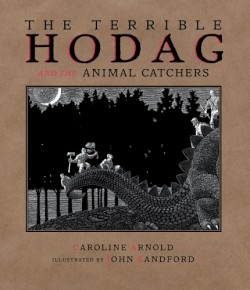The Terrible Hodag
Loch Ness has its monster and Wisconsin has its Hodag. Although neither has ever been captured, these mythological creatures have spawned wonderful tales and legends.
Generations of lumberjacks in the Wisconsin forests have amused themselves and townsfolk (who have festivals named for the creature) with stories of Hodag. The enormous Hodag has the head of an ox, feet of a bear, back of a dinosaur, and tail of an alligator. In this masterful children’s tale, the scary Hodag has his good points, and so he is protected by Olee Swenson and his fellow lumberjacks. It seems that Hodag once helped the lumberjacks “get rid of a mean boss man.” (Adult readers will savor the way it happened.)
Hodag helps his friends fell trees, an easy feat when he swishes his tail, and he has a fondness for ripe blueberries. The lumberjacks are worried about his welfare when they learn that animal catchers have come to trap Hodag and take him to a zoo. The creature wonders what he would eat and how he would survive in a small cage. He needn’t fret. Olee and the lumberjacks devise several plans to thwart the animal catchers. The trackers dig a pit—with a Rube Goldberg-style contraption—to catch the beast, using blueberries as bait. Finally, they find themselves at the bottom of it.
The dramatic black-and-white illustrations provide texture that invites touching. Design accents of red brighten the text pages. At times, the motion of the elements cannot be contained within the boxed frames. As Olee Swenson leans back and yells “timber,” his axe pushes through the frame. On other pages, Hodag’s horn or tail cannot be “caged” within the box. The illustrator has created art for a number of previous books, including Arglyle, Down Buttermilk Lane, and Moonstick. Here, Sandford depicts the animal catchers as delicate, scientific, and somewhat comical, rather than evil—armed with a net, rope, map, and book. Most are stationary and wear a monocle, pith helmet, or bowler. By contrast, the lumberjacks are burly, bearded, and in motion.
The author has written several award-winning books, including Cheetah, Easter Island, and Dinosaur Mountain. In this Hodag story, Arnold is sympathetic to the animal catchers: they are rescued from the pit, eager to return to the city. Hodag will stay in the forest: “It was his home and where he belonged.”
The dialogue and story make The Terrible Hodag enjoyable to read aloud to young listeners, and the illustrations are vivid despite their monochromatic tones. Hodag may not be captured, but in this rendition, he is thoroughly captivating.
Reviewed by
Linda Salisbury
Disclosure: This article is not an endorsement, but a review. The publisher of this book provided free copies of the book to have their book reviewed by a professional reviewer. No fee was paid by the publisher for this review. Foreword Reviews only recommends books that we love. Foreword Magazine, Inc. is disclosing this in accordance with the Federal Trade Commission’s 16 CFR, Part 255.

